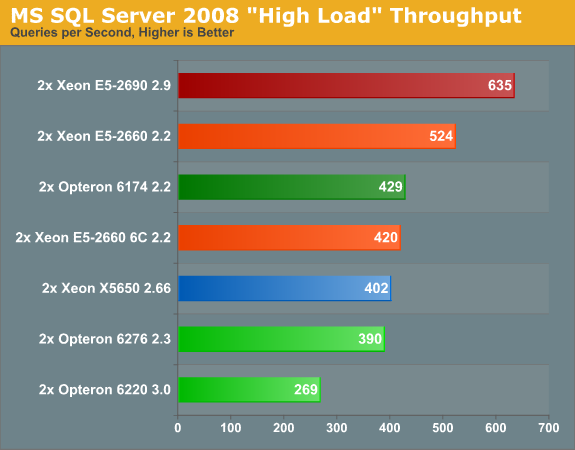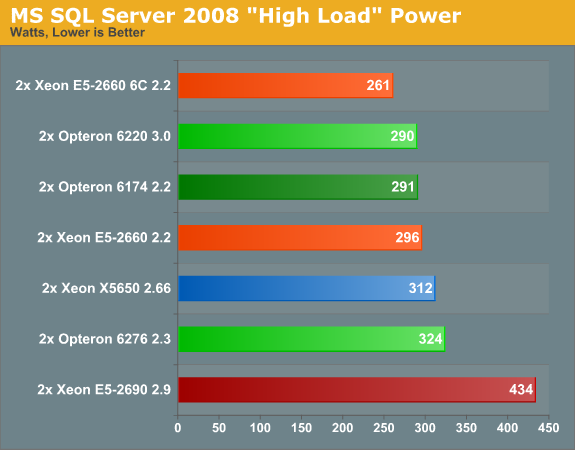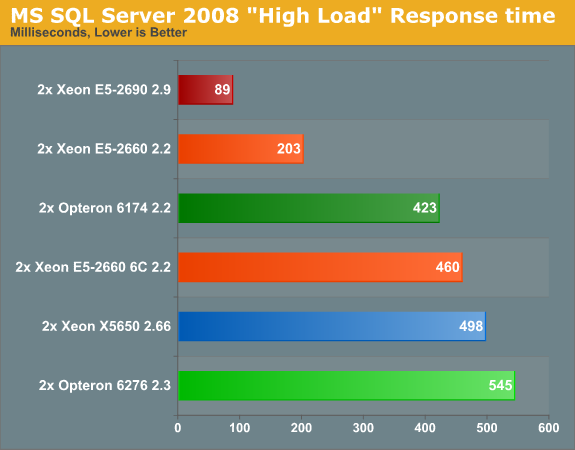The Xeon E5-2600: Dual Sandy Bridge for Servers
by Johan De Gelas on March 6, 2012 9:27 AM EST- Posted in
- IT Computing
- Virtualization
- Xeon
- Opteron
- Cloud Computing
SQL Server 2008 Enterprise R2
We have been using the Flemish/Dutch Web 2.0 website Nieuws.be as a benchmark for some time. 99% of the loads on the database are selects and about 5% of them are stored procedures. You can find a more detailed description here.
We have improved our testing methodology (read more about it here) and updated the SQL Server, so the results are only comparable to our last Opteron 6276 review (and not comparable to older ones than the latter).

Since performance/watt is an extremely important metric, we follow up with a power measurement:

The Xeon E5-2690 is by far the fastest in this discipline, but the difference power consumption compared to the rest of the pack is significant. The Xeon E5-2690 needs 140W more than its slower brother, the 95W TDP Xeon E5-2660. That is 70W extra per CPU. This clearly indicates that the fastest Xeon is running closer to its TDP than the 2.2 GHz version. The Xeon E5-2660 offers more than 20% better performance per Watt than the 135W TDP Xeon.
The Xeon E5-2660 is especially impressive if you compare it with the older Xeon. Despite the lower clockspeed, the new Xeon is capable of outperforming the Xeon 5650 by 30%.
Clock for clock, core for core the Xeon E5 is 23% more efficient at SQL Server workloads than its older brother. Considering that it is pretty hard to extract higher IPC out of server workloads, we can say that the Sandy-Bridge architecture is a winner when it comes to SQL databases.
Finally, let's check out the response times with 600 users sending off a query every second (on average):

Response times are more or less linear (and low!) when the server is not yet saturated . Once the server is closer to or over its maximum throughput, response times tend to increase almost exponentially. Since the Xeon E5-2690 is capable of sustaining more than 600 users, it can still offer a very low response time. The other CPUs are saturated at this point.
But as we pointed out in our previous article, server benchmarks at 100% are just one datapoint and we should test at lower concurrencies as well. Most people try to make sure that their database server almost never runs at 100% CPU load.










81 Comments
View All Comments
think-ITB-live-OTB - Tuesday, March 6, 2012 - link
Can i ask you a question? do you at least get paid when you bend over for Intel?These are Server Chips - who cares about single-threaded application performance.. or Corporate IPOs. AMD has delivered far greater TCO/performance than Intel has for at least a Decade and running.
You want to praise a company like a Deity? ARM Holdings. nuff said. They can design a 35 dollar computer that can decode H.264 better than Intel can on SoCs that run 4x's the price. Currently have more Chips in more devices than in Intels entire history and Push Power envelopes far beyond anything Intel could ever muster.
Just you wait before the Storm ARM and its Licensees unleash as it will eventually take over ALL markets including the Server space (Calxeda much?). Oh and as for Apple. (an ARM Licensee itself... i can see them moving to in-house ARM designs pretty soon). 4-6-8 Core Cortex A15 (with A7 core for low power iPod/tablet sync) Macbook Airs anyone?
Intel is becoming the strongest of the Dinosaurs. But even the T-Rex fell eventually.
swizeus - Wednesday, March 7, 2012 - link
We have been using the Flemish/Dutch Web 2.0 website Nieuws.be as a benchmark for some time. 99% of the loads on the database are selects and about 5% of them are stored procedures.The database is loaded 104%. is it possible ?
JohanAnandtech - Wednesday, March 7, 2012 - link
Stored procedures can contain selects :-)fredisdead - Saturday, April 7, 2012 - link
From the 'article' .....'The Opteron might also have a role in the low end, price sensitive HPC market, where it still performs very well. It won't have much of chance in the high end clustered one as Intel has the faster and more power efficient PCIe interface'
Well, if that's the case, why exactly would AMD be scoring so many design wins with Interlagos. Including this one ...
http://www.pcmag.com/article2/0,2817,2394515,00.as...
http://www.eweek.com/c/a/IT-Infrastructure/Cray-Ti...
U think those guys at Cray were going for low performance ? In fact, seems like AMD has being rather cleaning up in the HPC market since the arrival of Interlagos. And the markets have picked up on it, AMD stock is thru the roof since the start of the year. Or just see how many Intel processors occupy the the top 10 supercomputers on the planet. Nuff said ...
InsaneScientist - Wednesday, March 7, 2012 - link
Johan, where in the specs where you have this line:Transistors (Billion) 2,26 2x 1,2 2x 904 1,17
I sure hope that 2x 904 (Billion) is a typo... otherwise AMD has some serious explaining to do. ;)
Should be 2x ,904 (I think? Would be 2x .904 for me, I assume you follow the same rules...)
iliev - Wednesday, March 7, 2012 - link
Page 5, Benchmark ConfigurationR2208GZ4GSSPP specs table... E5-2660 is 2.2Ghz, and not 2.9GHz
dodge776 - Wednesday, March 7, 2012 - link
Hi Johan,Always look forward to reading your server reviews at AT, but no SAPS benchmarks this time?
ppennisi - Wednesday, March 7, 2012 - link
For maximum VMware performance on Opteron Interlagos cpu under VMWARE it's better to disable C1E and enable, where available, HPC mode.I found myself on a fresh installation of ESXi 5.0 on Dell R715 that leaving C1E enable literally crippled vm performance.
boudini - Thursday, March 8, 2012 - link
I'm not sure I would recommend using iray as a reliable benchmark renderer in 3ds max. It is not a self configuring mental ray, but an unbiased renderer which behaves fairly differently to mental ray, and most other renderers such as vray, final render and brazil. It is comparible to maxwell and fryrender, but is very new compared to those two longer established unbiased render engines. It also attempts to use the gpu to add to its calculations as well - which could significantly skew results.Using mental ray or vray might well give you quite a different result, and besides I don't think iray is widely used in the industry.
omega4711 - Friday, March 9, 2012 - link
This. The results of iray are mostly dependent on the GPU. The lack of proper scaling certainly isn't due to Amdahl's law. Just use mentalray with small enough render buckets and you can easily satisfy 64+ threads.Also, due to the limitations of iray, it can (at this moment) only be used in about 1-3% of real world scenarios.
Please, for all the people that care about these benchmarks, use mentalray and/or vray.
Otherwise, it's a brilliant article.